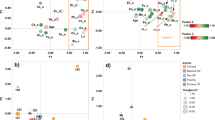Abstract
One hundred and twenty-two persons employed in an industrial waste incineration plant were examined with respect to organic and inorganic substances which may be produced during the combustion of different waste. The employees were divided into three groups: persons with contact with the incinerator (WI workers,n = 45), periphery workers (n = 54) and management (n = 23). For the evaluation of internal exposure, the levels of lead, cadmium, mercury, benzene, toluene, ethylbenzene andm-xylene in blood, chromium in the erythrocytes, polychlorinated biphenyls, hexachlorobenzene and pentachlorophenol in plasma, and arsenic, chromium, nickel, vanadium, chlorophenols and hydroxypyrene in urine were determined. The internal exposures of the three groups were tested against each other and were compared with the reference values of the general population. Differences between the groups investigated were tested using theU test according to Wilcoxon, Mann and Whitney (P < 0.05). The biological exposure limits valid in Germany (BAT values) were not exceeded in any cases. Compared with the background levels of the German population, certain parameters were exceeded in several employees. Significantly higher levels of the WI workers in comparison to both periphery workers and management were found for toluene in blood (median: 1.1 vs 0.9 vs 0.6 μg/l). For the lead and cadmium levels in blood and for the urinary excretion of arsenic, 2,4-dichlorophenol and tetrachlorophenols, statistical differences were found only between WI workers and one of the other groups. However, in all cases the elevations were very small and of interest more from the environmental than from the occupational point of view. It must be stressed that this waste incineration plant is very modern in terms of worker health and safety. At older plants without corresponding health and safety measures, higher internal exposure of the employees to hazardous substances may exist.
Similar content being viewed by others
References
ACGIH (1993/94) Threshold Limit Values and Biological Exposure Indices. Cincinnati, Ohio
Angerer J, Gündel J (1994) Benzene and alkylbenzenes. In: Angerer J, Schaller KH (eds) Analyses of hazardous substances in biological materials, vol 4. Deutsche Forschungsgemeinschaft, VCH, Weinheim, pp 107–130
Angerer J, Schaller KH (1985–1994) Analyses of hazardous substances in biological materials, vol 1-4. Deutsche Forschungsgemeinschaft, VCH, Weinheim
Angerer J, Scherer G, Schaller KH, Müller J (1991) The determination of benzene in human blood as an indicator of environmental exposure to volatile aromatic compounds. Fresenius J Anal Chem 339:740–742
Angerer J, Heinzow B, Schaller KH, Weltle D, Lehnert G (1992a) Determination of environmentally caused chlorophenol levels in urine of the general population. Frensenius J Anal Chm 342:433–438
Angerer J, Heinzow B, Reimann DO, Knorz W, Lehnert G (1992b) Internal exposure to organic substances in a municipal waste incinerator. Int Arch Occup Environ Health 64:265–273
Ballschmiter K, Braunmiller I, Niemcyk R, Swerev M (1988) Reaction pathways for the formation of polychlorodibenzodioxins (PCDD) and -dibenzofurans (PCDF) in combustion processes. II. Chlorobenzenes and chlorophenols as precursors in the formation of polychloro-dibenzodioxins and -dibenzofurans in flame chemistry. Chemosphere 17:995–1005
Beck H, Mathar W (1985) Analysenverfahren zur Bestimmung von ausgewähiten PCB-Einzelkomponenten in Lebensmitteln. Bundesgesundheitsamt 28:1–12
Bomhard A, Schaller KH, Triebig G (1984) Capillar-Gas-Gaschromatographie mit ECD- und MS-Detektion zur quantitativen Bestimmung von Pentachlorphenol im menschlichen Plasma und Ham. Fresenius Z Anal Chem 319:516–519
Böske J, Dreier M, Päpke O (1995) Polychlorierte Dibenzodioxine und Dibenzofurane im Blut von Mitarbeitern einer Müllverbrennungsanlage. Arbeitsmed Sozialmed Umweltmed 30:348–354
DFG Senatskommission zur Prüfung gesundheitsschädlicher Arbeitsstoffe (eds) (1995) MAK- und BAT-Werte-Liste. VCH, Weinheim
Göen T, Gündel J, Schaller KH, Angerer J (1995) The elimination of 1-hydroxypyrene in the urine of the general population and workers with different occupational exposure to PAH. Sci Total Environ 163:195–201
Hahn JL, Sofaer DS (1991) Abschätzung der Gesundheitsrisiken durch Emissionen aus zwei Müllkraftwerken. Staub-Reinhaltung der Luft 51:133–138
Hasberg W (1989) Drehrohrofen und Nachbrennkammer als chemischer Reaktor zur Rückstandsverbrennung. WLB — Wasser, Luft und Boden 11/12:18–24
Jongeneelen FJ, Anzion RB (1991) Hydroxypyrene. In: Angerer J, Schaller KH (eds) Analyses of hazardous substances in biological materials, vol 3, Deutsche Forschungsgemeinschaft, VCH, Weinheim, pp 151–169
Lehnert G (1980) Biologische Arbeitsstoff-Toleranz-Werte: Ein Konzept zur Individualpravention bei Exposition gegenüber gesundheitsschädlichen Arbeitsstoffen. Arbeitsmed Sozialmed Präventivmed 15:266–270
Lehnert G, Angerer J, Göen T, Schaller KH (1994) Referenzwerte für persistente Gefahrstoffe am Beispiel der Konzentration an Polychlorierten Biphenylen im Humanserum. Arbeitsmed Sozialmed Umweltmed 29:454–458
Lustenhouwer JWA, Olie K, Hutzinger O (1980) Chlorinated Dibenzo-p-dioxins and related compounds in incinerator effluents. Chemosphere 9:501–522
Schulte E, Lewalter J, Ellrich D (1991) Polychlorinated biphenyls. In: Angerer J, Schaller KH (eds) Analyses of hazardous substances in biological materials, vol 3. Deutsche Forschungsgemeinschaft, VCH, Weinheim, pp 231–261
Wrbitzky R, Angerer J, Lehnert G (1994) Chlorphenole im Ham als umweltmedizinischer Parameter. Gesundheitswesen 56:629–635
Author information
Authors and Affiliations
Rights and permissions
About this article
Cite this article
Wrbitzky, R., Göen, T., Letzel, S. et al. Internal exposure of waste incineration workers to organic and inorganic substances. Int. Arch Occup Environ Heath 68, 13–21 (1996). https://doi.org/10.1007/BF01831628
Received:
Accepted:
Issue Date:
DOI: https://doi.org/10.1007/BF01831628



